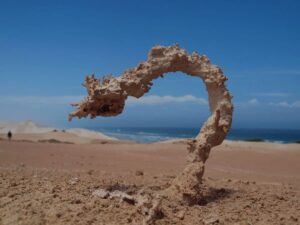What is Fulgurite And How Is It Created?
Fulgurite is named after the Latin word ‘fulgur,’ which means ‘lightning.’ This is because when lightning strikes sand, fulgurite is produced. Around 1800 °C, most sand melts, and lightning can have up to 30,000°C in the atmosphere. When a lightning bolt strikes the sand, the silica melts almost immediately, cooling and fusing. It usually has the shape of a tube, with smooth inner and rough, grainy exterior walls. The roughness on the outside is due to the fact that the sand from the center does not completely melt and retains some of its original shapes. The ‘lightning glass,’ which forms after lightning strikes, is composed of whatever sand is available in the area. This means that fulgurites are made up of a variety of minerals rather than a single mineral. That is why fulgurite is referred to as a mineraloid rather than a mineral.
Fulgurite can occur not just in the sand but also in silica-rich rocks. The majority of these ‘rock fulgurites’ are pretty small and difficult to locate. Fulgurite is officially known as lechatelierite variety fulgurite. Lechatelierite is a type of glass that forms under extreme pressure and heat, and tektite is an example. When a meteorite collides with sand, tektite is created; the most well-known example is the gemstone moldavite.
Fulgurite is usually only a few millimeters in size. However, under the right conditions, much larger fulgurites can be found. Unfortunately, keeping these in one piece is difficult due to the fragility of fulgurites of this size.
Fulgurite Properties
The hardness of fulgurite is determined by the sand or rock from which it was created. Fulgurites, in general, are not very tough and can be easily damaged.
What is Fulgurite & What colors
The color of fulgurite is determined by the type of sand used to strike it. White, yellow, grey, and reddish are standard colors. Black fulgurite does exist; however, it is extremely rare.
You are dealing with colored or manufactured fulgurite if you detect a color that isn’t seen in the sand.
What is Fulgurite & Sources
Fulgurite is a mineral that may be found all over the world. Only lightning and sand or silica-rich rocks are required to produce fulgurite, and beaches and deserts are the most familiar sources.
What is Fulgurite & It’s Uses>
Fulgurite is only used for decorative purposes. Although it is usually found in mineral collections, fulgurite jewelry is also available.
Where Can I Find Fulgurite Myself?
If you know what to look for, finding fulgurites is not tricky. Because few people are looking for them, even sites with many visitors can be an excellent place to look. Beaches and deserts are the ideal areas to look for fulgurites.
The greatest location to begin your search is in areas that are higher than the surrounding area. Dunes near the beach and little hills in the desert are two examples.
Even though mountaintops are frequently struck by lightning, it is challenging to detect fulgurites there. The majority of the rocks on these mountaintops are deficient in silica, which results in scorch traces at best.
After a violent lightning storm has passed across the area, it is the optimum time to begin your search. Do not walk outside during or immediately following a lightning storm. You don’t have to be concerned that someone will find fulgurites before you because only a small percentage of people are aware of their existence, and even fewer actively seek them out.
What is Fulgurite & How Can I Make Fulgurite?
To make a fulgurite, all that is necessary is a strong stream flowing through a silica-rich source (sand is the best choice).
Keep a close eye on the forecast. If a large storm is projected to strike your area, you should start making preparations as soon as possible. You should search out an exposed location with plenty of sand (or bring your own) higher than the surrounding area.
One or more metal spikes or rods should be pushed about a foot into the ground at this point. The greater the distance between the rod and the bottom, the better. There’s no assurance that lightning will strike your rod, so try a few different locations to increase your chances.
This should not be done near people, animals, or property. Ensure that you have permission to place the metal bars, and no restrictions prevent you from removing the fulgurite afterward. If you are lucky and your metal rod was struck by lightning, don’t touch it or the sand just yet. If you are not careful, you could seriously burn your hands; make sure everything is cold before continuing.
Fulgurite Value
Fulgurite is a relatively inexpensive mineral, and it is usually sold for a few dollars per gram by most dealers (not carat). Due to their uniqueness, vast and white pieces might sell for significantly more. Fulgurite, with a lot of branches, is mainly in high demand. Even yet, a stunning part of fulgurite can be purchased for less than $100.
In most cases, only the best fulgurites are utilized in jewelry. This is why the majority of sterling silver fulgurite pendants cost between $50 and $100. Since gold will easily triple the pendant price, that’s why gold fulgurite pendants are rare. Only a few retailers sell fulgurite jewelry, and none of them specialize in it.
Fulgurite Enhancements
It is unclear if fulgurite can be improved. However, some vendors may ‘repair’ broken fulgurites. They will glue together parts of fulgurite that were once part of a larger fulgurite, and in extreme circumstances, they will glue anything that looks decent together.
Similar Gemstones
Lechatelierite variations are the only gemstones that are similar to fulgurite. Tektite glass, formed from meteor strikes, is the most well-known. The best-known example is moldavite. Moldavite is a green mineral; however, it can also contain white tektites.
